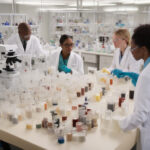Canada is making significant strides in the realm of particle physics, particularly through its contributions to the upgrades of CERN’s Large Hadron Collider (LHC). The LHC, the world’s largest and most powerful particle accelerator, is on the verge of a cutting-edge transformation aimed at enhancing its luminosity. This advancement is set to unlock new avenues for research and deepen our understanding of fundamental particles and forces.
TRIUMF, Canada’s national laboratory for particle and nuclear physics, has outlined its pivotal role in these high-luminosity upgrades. With these upgrades, the LHC will be able to collide protons more frequently, leading to a tenfold increase in data production. This dramatic boost will facilitate more precise measurements and potentially unveil new particles that could reshape our current understanding of the universe.
For instance, the enhanced capabilities could shed light on elusive phenomena such as dark matter and the Higgs boson mass. Canadian physicists are also developing new technologies to improve detection systems, ensuring that the valuable data collected will be analyzed effectively.
CERN serves as a collaborative platform, bringing together scientists from around the globe. Canada’s commitment not only positions it as a leader in particle physics but also fosters international partnerships vital for groundbreaking discoveries. With a robust network of researchers and institutions, Canada’s input in the LHC’s upgrades exemplifies the country’s dedication to advancing scientific knowledge.
As these enhancements move forward, Canada’s contributions to the LHC highlight the country’s significant role in the future of particle physics research, showcasing innovative solutions that promise to redefine our understanding of the universe. This endeavor not only reinforces Canada’s scientific stature but also contributes to global knowledge, underscoring the importance of international scientific collaboration.












